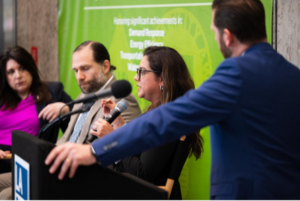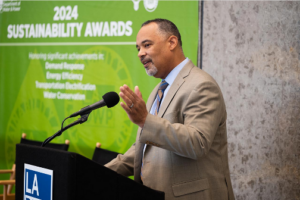When Mike Whitmire co-founded accounting workflow automation platform FloQast Inc.
in 2013, he wanted to address and streamline
the pain points of business accounting work that he had experienced firsthand.
The Sherman Oaks-based company has since grown to serve about 2,800 clients and recently reported a post-money valuation north of $1.6 billion. FloQast closed a $100 million series E round this month and is now charging towards an initial public offering.
When managing financial operations at a business, an accountant must handle tasks such as month-end closes, compliance and risk management, daily processing treasury, procurement, reporting and balance sheet reconciliation. FloQast’s tools include a collaboration workflow software platform that supports processes such as month-end close and reconciliation automation, reporting and compliance management, as well as free professional education and development courses.
Its products are used by public and private clients, including Twilio Inc., the Los Angeles Lakers, Shopify Inc., the Golden State Warriors, Docusign Inc. and Snowflake Inc. The platform is offered on a SaaS model which is priced based on a clients’ company and team size. Additional revenue for FloQast comes from implementation-related service fees.
Background in accounting
As a licensed certified public accountant, Whitmire previously spent three years as a senior accountant at Santa Monica-based software provider Cornerstone OnDemand Inc. While there, he worked extensively on Cornerstone’s IPO in 2011, which he said was executed in a 12-month period. Cornerstone later went private in 2021 through a reported $5.2 billion acquisition by Santa Monica-based Clearlake Capital Group.
Whitmire said that his time with Cornerstone allowed him to learn about how a sales department interacts with customers, the go-to-market side of a business, how a SaaS company operates and the best operational times to hire new staff.
“For those not in the accounting world, I would just stress (12 months) is a psychotic timeframe to try to go … from zero to IPO,” Whitmire said. “But I got to learn so much about everything that we had going on in my time at Cornerstone, and I really heavily attribute that to the success of FloQast. Not just the product, (but also) the collaboration workflow and, on the nerdier side, the tie-out and reconciliation process automation.”
He later co-founded FloQast with Chris Sluty and Cullen Zandstra, who now respectively serve as chief product officer and chief technology officer. The platform originally focused on integrating with Excel and streamlining “pain points” within that software. It has evolved to offer broad integrations from Excel and cloud storage to enterprise resource planning and bank integrations. Whitmire said FloQast’s internal mantra is to go down the balance sheet and automate as much as possible, including workflows, reconciliation, audit request lists and compliance.
“There’s a massive talent crunch inside of audit, so anything we can do to automate the mundane work between the auditors and the accountants, I think, is a really big value add,” Whitmire said. “That has certainly landed with our customers and our prospects, and that product is doing extremely well.”
FloQast later noticed that some clients – such as Zoom Video Communications Inc. – were using its software for unintended purposes, such as managing payroll processing and other non-close related workflows. FloQast decided to pivot its platform to accommodate this unexpected user activity. In late 2020, it began to roll out a tool called FloQast Ops. This allows users to view the status of all accounting operations, including accounts payable, payroll and Securities and Exchange Commission reporting, from one dashboard.
‘Customers aren’t just helped, they’re deeply understood’
FloQast’s post-money valuation has grown 33% since a 2021 valuation of $1.2 billion, and it announced $100 million of annual recurring revenue earlier this year. Whitmire repeatedly referred to his focuses and forward-looking missions at FloQast as “maniacal.” However, the growth tactics and manners of operation that he describes are metered and intentional: for example, the company hires carefully, has maintained a steady rate of growth and has a “strong culture” of internal promotions. Whitmire said that these strategies helped FloQast to avoid implementing any layoffs in the last few years. Its team size has still grown considerably in the last decade – FloQast’s current headcount is 649, up from 40 in 2017.
“On the one hand, yeah, I would love to grow 300% one of these years, but (our current growth) makes the business way more predictable and allows us to not get out in front of our skis with hiring,” Whitmire said. “We’ve been able to preserve cash and really be smart about things.”
One unique strategy that FloQast has stuck to is hiring accountants into customer-facing roles – 35% of its employees are former accountants, and all its sales engineers and implementation team members are trained accountants. FloQast promotes its platform as technology that is built “by accountants, for accountants,” and it said that hiring accountants themselves has been an “important metric” for its success.
“FloQast capitalizes on accounting institutional knowledge and it’s been a driving force in our competitive differentiation,” Whitmire said. “Customers aren’t just helped, they’re deeply understood … most of the pain points (that) customers experience or look to solve are ones our team has experienced firsthand.”
Whitmire said investors initially pushed back against the strategy, calling it a decade-long “battle” that he personally fought for.
“There was one board meeting where I presented these statistics around the success rate of sales executives that we hired who did not have a background in accounting, versus those that we promoted and did have a background in accounting,” Whitmire said. “The analysis I put together was so damning that we agreed that we should not be hiring externally, we should be promoting internally.”
Planning to go public
The company’s previous fundraises include a $110 million series D funding round in 2021 and a $40 million series C round in 2020, on top of its 2013 participation in the Venice-based Amplify.LA accelerator program. Whitmire said that most of FloQast’s recent funding will go towards laying the “groundwork” to become a publicly-traded company, as well as to support international expansion and product development.
While an IPO has been a dream for Whitmire since high school, he said that FloQast is still a “couple years out” from that. He added that FloQast intends for the recent series E funding to be its final investment round before heading into an IPO.
“I would like to be able to grow the revenue number, land in more geographies, expand up market (and) build more of our solutions before we head into that IPO,” Whitmire said. “(Once) the foundation for the business is in that situation, then we’ll be ready to operate like a public company and really focus on consistent growth, earnings before interest, taxes, depreciation and amortization, margins and all that good stuff. There’s still some more groundwork to be laid with venture capital money that’s a little more open to those types of investments.”







OpEd: LA Olympics: Let’s Help Minorities Win
The Los Angeles 1984 Summer Olympics introduced several innovations, such as the first-ever computerized scoring systems. These Olympics were financially successful, mainly due to corporate sponsorships and limited public funding.
As a result, the 1984 Summer Olympics were a triumph for the United States: They established a legacy of organizational proficiency (expected from the upcoming Paris 2024 games). And they infused the city with a dramatic economic impact.
With the return to Los Angeles of the Summer Olympics just four years away, I share the civic pride of L.A. in the international spotlight. And yet, in terms of equitable impact, it is clear that the 1984 Olympics failed to get all of the city’s economic players into the game. They proved, once again, how the Black community rarely scores a home run, despite demonstrating prowess on the field.
There are specific policy and market-based reasons why my community has been unable to reap the largess of events such as the Olympics. They are part of the institutional handicaps – such as the “redlining” of Black neighborhoods, which stifled generational wealth – that has kept these communities stranded on third base for centuries.
Housing is still a concern
Housing and real estate were instrumental in the concentrated disadvantage of Blacks in all U.S. cities. Government and private actors erected barriers to investment and homeownership in Black communities. According to the 2023 “State of Black Los Angeles County Report,” Black people have the region’s smallest homeownership rate: 33.5%, compared to Whites at 53.9%. Consider the impact on the economic game where the average White home value exceeds Black home values 1.65 times, and where many Black neighborhoods are locked in a downward spiral of devaluation, disinvestment and deterioration.
With the arrival of the LA28 games, I share the concern that infrastructure investments, which hold the promise of elevating property values, will once again strand or even price out many longtime residents.
What needs to be done
I am joining the city’s top business and development experts in “Urban Marketplace 24: From LA84 to LA28 and Beyond,” presented by Urban Land Institute, Los Angeles District Council, on April 24 at the Beehive in South Los Angeles. “Insights and Investments to Narrow the Racial Wealth Gap” will offer examples of how business, community and political leaders can coach investment in historically underserved Black and brown communities.
With an emphasis on wealth enhancement, Urban Marketplace offers achievable means of environmental equity and social justice. We suggest the following steps:
1. Monitoring and Evaluation: Establish a system to assess the impact of the Olympics on low-income communities. This will help identify areas of improvement so that economic benefits reach people and places that most need it.
2. Infrastructure Development: Invest in low-income areas, including transportation, housing and public spaces. This will improve the quality of life and create a foundation for improving the built environment where equitable development is needed, and deployment of capital jump-starts job opportunities during the construction phase.
3. Job Creation and Training: Implement employment opportunities for residents in low-income communities. This can include workforce-development initiatives, apprenticeship programs and partnerships with local businesses and organizations.
4. Small-Business Support: Help ensure that low-income communities can benefit from increased economic activity during the Olympics. This can include access to capital, technical assistance, corporate mentorship programs and marketing assistance to local business improvement districts.
5. Attainable Housing: Develop inclusive housing options in close proximity to Olympic venues to ensure that low-income residents have improved access and benefit from the Games. This can be achieved with community-based housing developers and inclusionary zoning policies. Innovative ownership options must also be designed and deployed.
6. Community Facilities and Programs: Enhance and create parks, recreational centers and youth programs in low-income areas. This will provide opportunities for residents to engage in the many sports, recreational and cultural events associated with the Olympics.
7. Education and Youth Development: Invest in educational programs and initiatives for youth development in low-income communities. This can include programs such the ULI Los Angeles’ UrbanPlan, which introduces high school students to the trade-offs and risks at play in the entitlement and negotiation process associated with real estate development, especially in public/private partnerships. Also deserving support are mentoring programs and after-school activities that promote sports, arts, financial literacy and basic academic achievements.
8. Environmental, Social and Governance Principles: Ensure that all aspects of the Olympic experience are planned and executed with an ESG focus. This can include promoting renewable energy, waste reduction and environmentally friendly transportation options.
9. Community Engagement: Engage with local leaders, organizations and residents to understand their needs, concerns and aspirations, and directly address the specific challenges faced by low-income communities.
By implementing these steps, Los Angeles can ensure that the 2028 Olympics leave a positive and lasting impact on its low-income communities.
Michael Banner was raised in Watts and attended Jordan High School. He is president and CEO of the Los Angeles LDC, a mission-driven community development financial advisory organization. He is a founding member of the ULI Los Angeles Urban Marketplace.